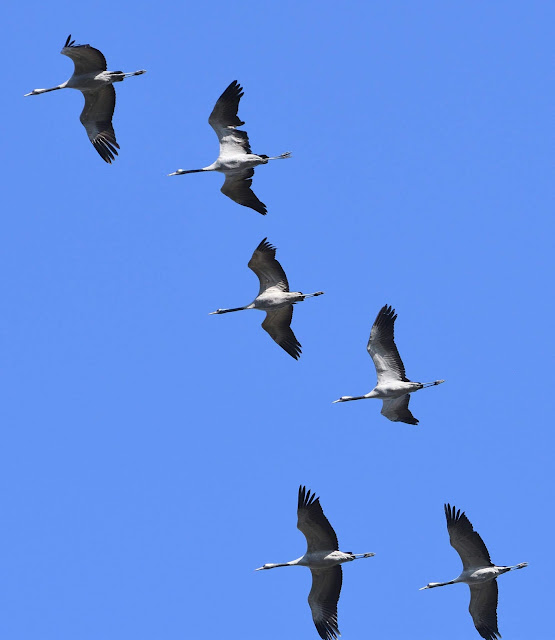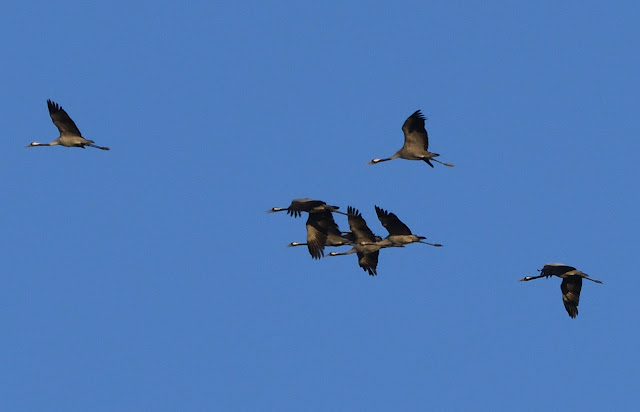Photographed this week, the Eurasian Crane Migration is a spectacular experience!
This week, I have been lucky enough to witness and photograph one of natures great migrations. That of the Eurasion (or Common) Crane. The migration takes these stunning birds over 3,000 thousand miles from their wintering grounds in North Africa, to Finland, Norway and Russia.
The Common Crane is one of the largest birds in Europe with a wingspan of over 2 meters and a weight of 4 - 6 kg. Overall plumage is a nearly uniform grey with long legs and neck. Adults are distinguished by the blue/grey and white contrast to the neck and head marked with a bright red spot, whilst young Cranes have a brownish plumage that they keep for a year that then gradually changes to adult plumage.
Cranes are very sociable and gregarious during their migration when they can form very large groups, which can be many tens of thousands. They are however, extremely territorial when nesting.
The western europe breeding grounds are situated principally in Finland, Sweden, Norway and the Baltic countries where large solitary nests using dry grass are constructed on the ground situated in large areas of marsh or swamp forests that can occupy up to several hundred hectares. Here a couple will produce one or two eggs in May that take about 4 weeks to hatch.
Shortly after hatching, the chicks are able to follow their parents and sneak into the swamp in search of insects, molluscs and small vertebrates, which then make up the bulk of their food. Thereafter, they consume more plants, such as tender herbs, aquatic plants and berries. The young start to take to the air at around two months of age between mid July and August, when they have to prepare for their first migration, when they will stay with their parents until their return in the spring. Sexual maturity isn’t actually achieved for between 3 and 5 years, when assuming they find a partner, they pair for life.
Winter migration starts in October when over 200,000 birds head south through France and onwards down as far as Spain and North Africa. I am fortunate, to live directly below their flightpath in South West France and the spectacle of groups of hundreds of birds at a time is simply breathtaking.
Over recent years, changes in behaviour have included some birds deciding that the improving winter temperatures here in France, have made it worthwhile overwintering here, rather than continuing to their normal wintering grounds. In fact, just south of Bordeaux, upwards of 60,000 birds are now regularly over-wintering on the marshes.
Commencing in late January, the return Spring migration starts and tends to peak in February and into March, with the Northerly route being the same, as flown when travelling South. On both migrations they will fly by night and by day with altitudes normally between 2000 to 5000 meters. However, they do fly as high as 9000 meters when crossing the alps and as low as 200 meters under certain conditions, before circling and regaining altitude. Most estimates of flight speed puts them at between 40 to 80 km/h, depending on the wind direction.
The call of these birds is incedibly loud and we can normally hear them from miles away and well before spotting them in the sky. Although, we usually watch them at high altitude and 'out of reach' of even the most powerful telephoto lens, on rare occasions, we are treated to a 'low-level' (sub 500 meter) fly-pass. On these occasions, the birds will regularly 'circle' above us, gradually gaining height on 'thermals' with each turn, until they reach a height of 2000 meters or more and head off again on their chosen path.
Many wetlands in Europe have been destroyed through drainage. This has meant that in some countries the crane population has suffered a sharp decline or entirely disappeared.
With the aid of intensive protection measures it has proved possible to make the migration route over France to Spain significantly safer. The result is that the breeding populations in North and Central Europe have begun to recover in the last few years.
Thanks to EU subsidies, French farmers are compensated for damage to crops, caused by cranes 'stopping over' during the migration. In fact, many areas under the flightpath have also benefitted from 'out of season' tourism, thanks to the draw of this amazing migration.
Over recent years, we have found the 'busiest' days of the spring migration, to have been during the last week in February, so if your travels bring you in this direction at that time of year, keep your gaze to the skies, listen out and experience one of natures greatest events!
If you enjoy reading my photoblogs, please 'subscribe' or 'share', utilising
the links at the top of the page.
To read my previous blogs, please click on the 'Previous Blogs' link
at the top left of this page.












Wow that shot against the moon is amazing. You obviously have a better zoom than I have I cannot get them that close. Great post and full of info. Take care Diane
ReplyDelete